University Economics Homework: Trade, Tariffs, and Market Analysis
VerifiedAdded on 2021/05/27
|9
|1546
|137
Homework Assignment
AI Summary
This economics assignment delves into fundamental economic principles, beginning with an exploration of absolute and comparative advantage using real-world scenarios. It then analyzes the impact of free trade versus tariffs on domestic steel markets, examining consumer and producer surplus, and welfare implications. The assignment further discusses international trade restrictions, including the infant industry argument and job protection, while also critically evaluating their potential negative consequences. Finally, it investigates the effects of tariffs on exporting markets, detailing changes in consumer and producer surplus, and overall welfare. The assignment concludes with a discussion on the advantages of free trade, such as increased competition, efficient resource allocation, and benefits to consumers through lower prices.
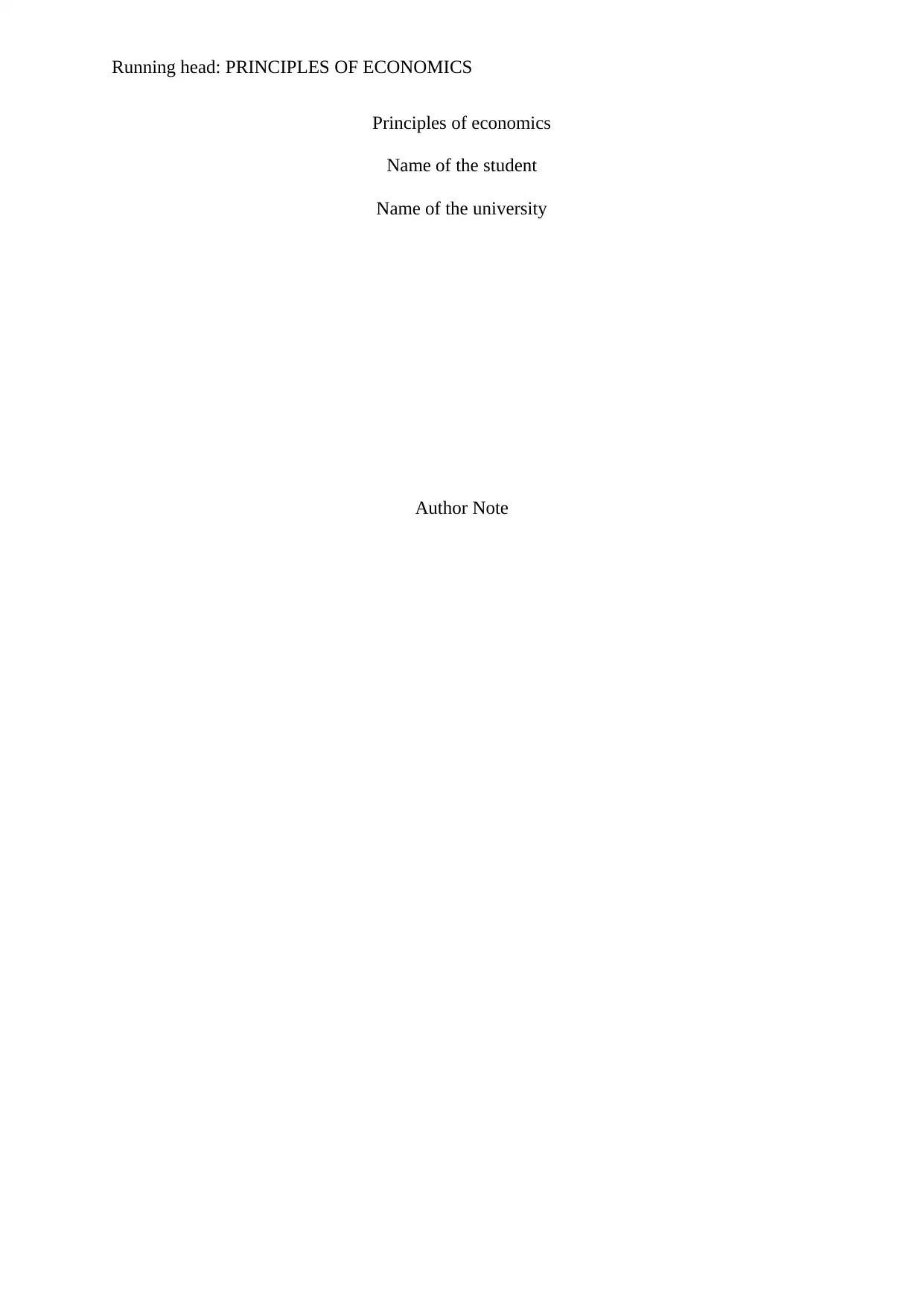
Running head: PRINCIPLES OF ECONOMICS
Principles of economics
Name of the student
Name of the university
Author Note
Principles of economics
Name of the student
Name of the university
Author Note
Paraphrase This Document
Need a fresh take? Get an instant paraphrase of this document with our AI Paraphraser
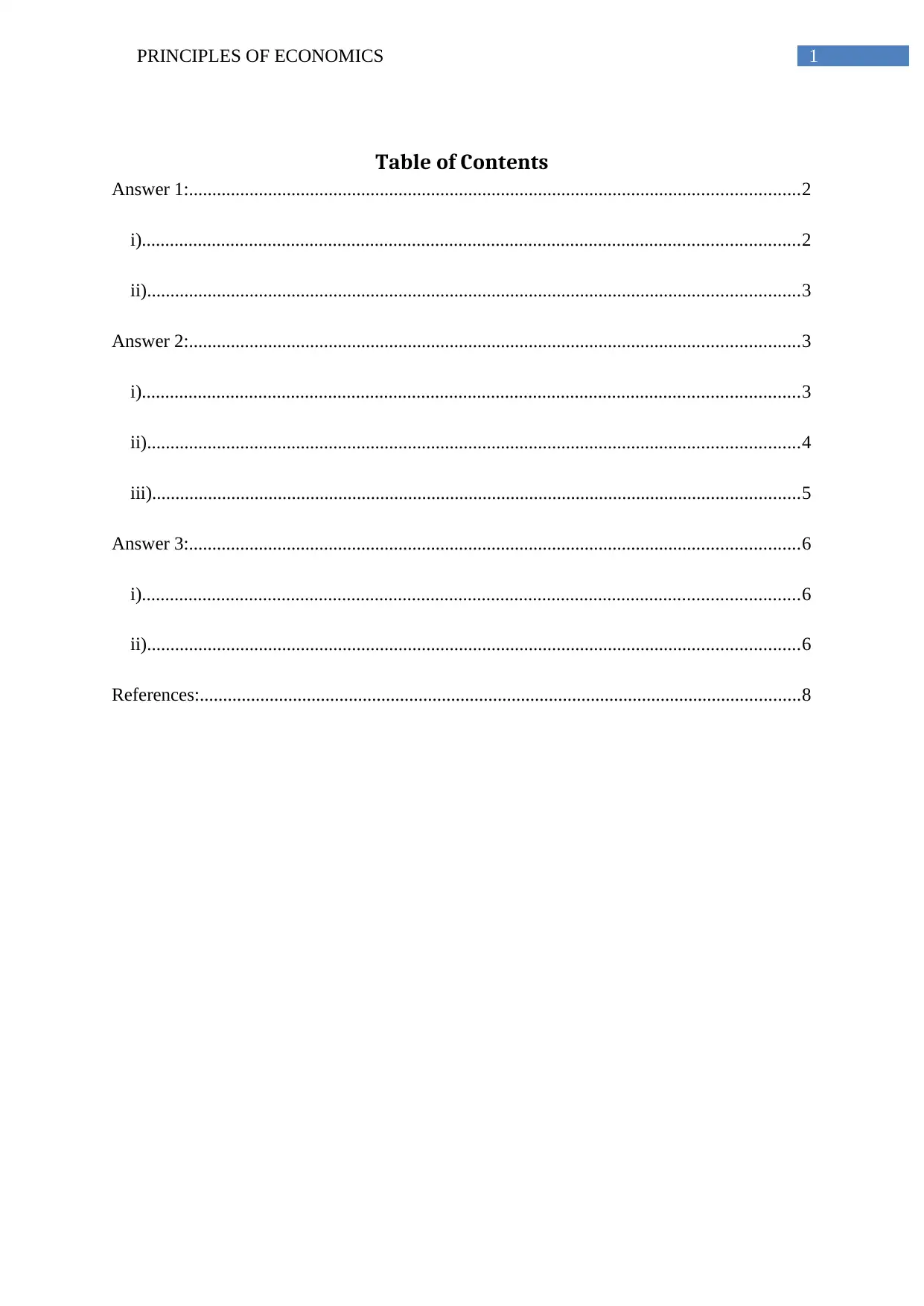
1PRINCIPLES OF ECONOMICS
Table of Contents
Answer 1:...................................................................................................................................2
i).............................................................................................................................................2
ii)............................................................................................................................................3
Answer 2:...................................................................................................................................3
i).............................................................................................................................................3
ii)............................................................................................................................................4
iii)...........................................................................................................................................5
Answer 3:...................................................................................................................................6
i).............................................................................................................................................6
ii)............................................................................................................................................6
References:.................................................................................................................................8
Table of Contents
Answer 1:...................................................................................................................................2
i).............................................................................................................................................2
ii)............................................................................................................................................3
Answer 2:...................................................................................................................................3
i).............................................................................................................................................3
ii)............................................................................................................................................4
iii)...........................................................................................................................................5
Answer 3:...................................................................................................................................6
i).............................................................................................................................................6
ii)............................................................................................................................................6
References:.................................................................................................................................8
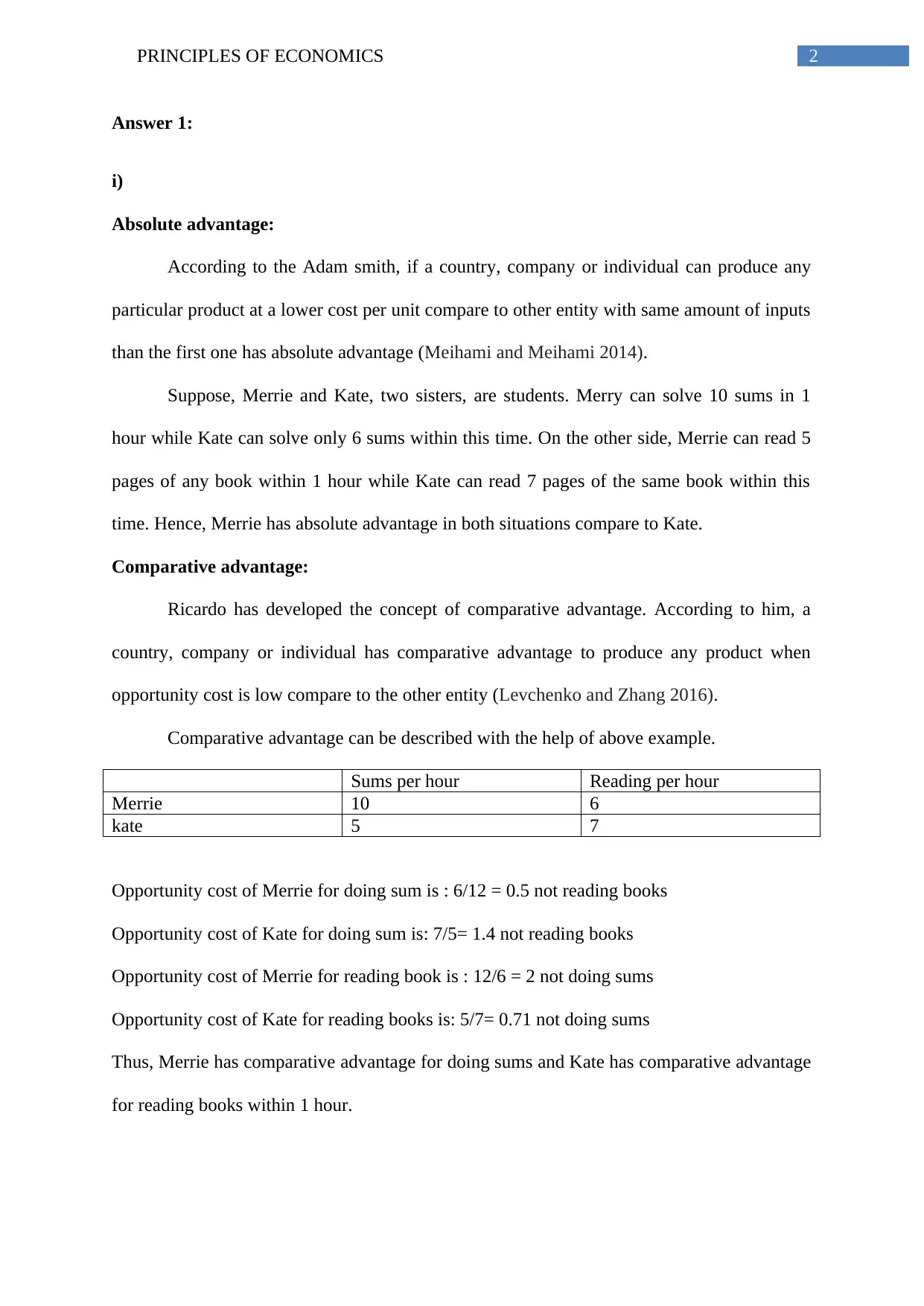
2PRINCIPLES OF ECONOMICS
Answer 1:
i)
Absolute advantage:
According to the Adam smith, if a country, company or individual can produce any
particular product at a lower cost per unit compare to other entity with same amount of inputs
than the first one has absolute advantage (Meihami and Meihami 2014).
Suppose, Merrie and Kate, two sisters, are students. Merry can solve 10 sums in 1
hour while Kate can solve only 6 sums within this time. On the other side, Merrie can read 5
pages of any book within 1 hour while Kate can read 7 pages of the same book within this
time. Hence, Merrie has absolute advantage in both situations compare to Kate.
Comparative advantage:
Ricardo has developed the concept of comparative advantage. According to him, a
country, company or individual has comparative advantage to produce any product when
opportunity cost is low compare to the other entity (Levchenko and Zhang 2016).
Comparative advantage can be described with the help of above example.
Sums per hour Reading per hour
Merrie 10 6
kate 5 7
Opportunity cost of Merrie for doing sum is : 6/12 = 0.5 not reading books
Opportunity cost of Kate for doing sum is: 7/5= 1.4 not reading books
Opportunity cost of Merrie for reading book is : 12/6 = 2 not doing sums
Opportunity cost of Kate for reading books is: 5/7= 0.71 not doing sums
Thus, Merrie has comparative advantage for doing sums and Kate has comparative advantage
for reading books within 1 hour.
Answer 1:
i)
Absolute advantage:
According to the Adam smith, if a country, company or individual can produce any
particular product at a lower cost per unit compare to other entity with same amount of inputs
than the first one has absolute advantage (Meihami and Meihami 2014).
Suppose, Merrie and Kate, two sisters, are students. Merry can solve 10 sums in 1
hour while Kate can solve only 6 sums within this time. On the other side, Merrie can read 5
pages of any book within 1 hour while Kate can read 7 pages of the same book within this
time. Hence, Merrie has absolute advantage in both situations compare to Kate.
Comparative advantage:
Ricardo has developed the concept of comparative advantage. According to him, a
country, company or individual has comparative advantage to produce any product when
opportunity cost is low compare to the other entity (Levchenko and Zhang 2016).
Comparative advantage can be described with the help of above example.
Sums per hour Reading per hour
Merrie 10 6
kate 5 7
Opportunity cost of Merrie for doing sum is : 6/12 = 0.5 not reading books
Opportunity cost of Kate for doing sum is: 7/5= 1.4 not reading books
Opportunity cost of Merrie for reading book is : 12/6 = 2 not doing sums
Opportunity cost of Kate for reading books is: 5/7= 0.71 not doing sums
Thus, Merrie has comparative advantage for doing sums and Kate has comparative advantage
for reading books within 1 hour.
⊘ This is a preview!⊘
Do you want full access?
Subscribe today to unlock all pages.

Trusted by 1+ million students worldwide
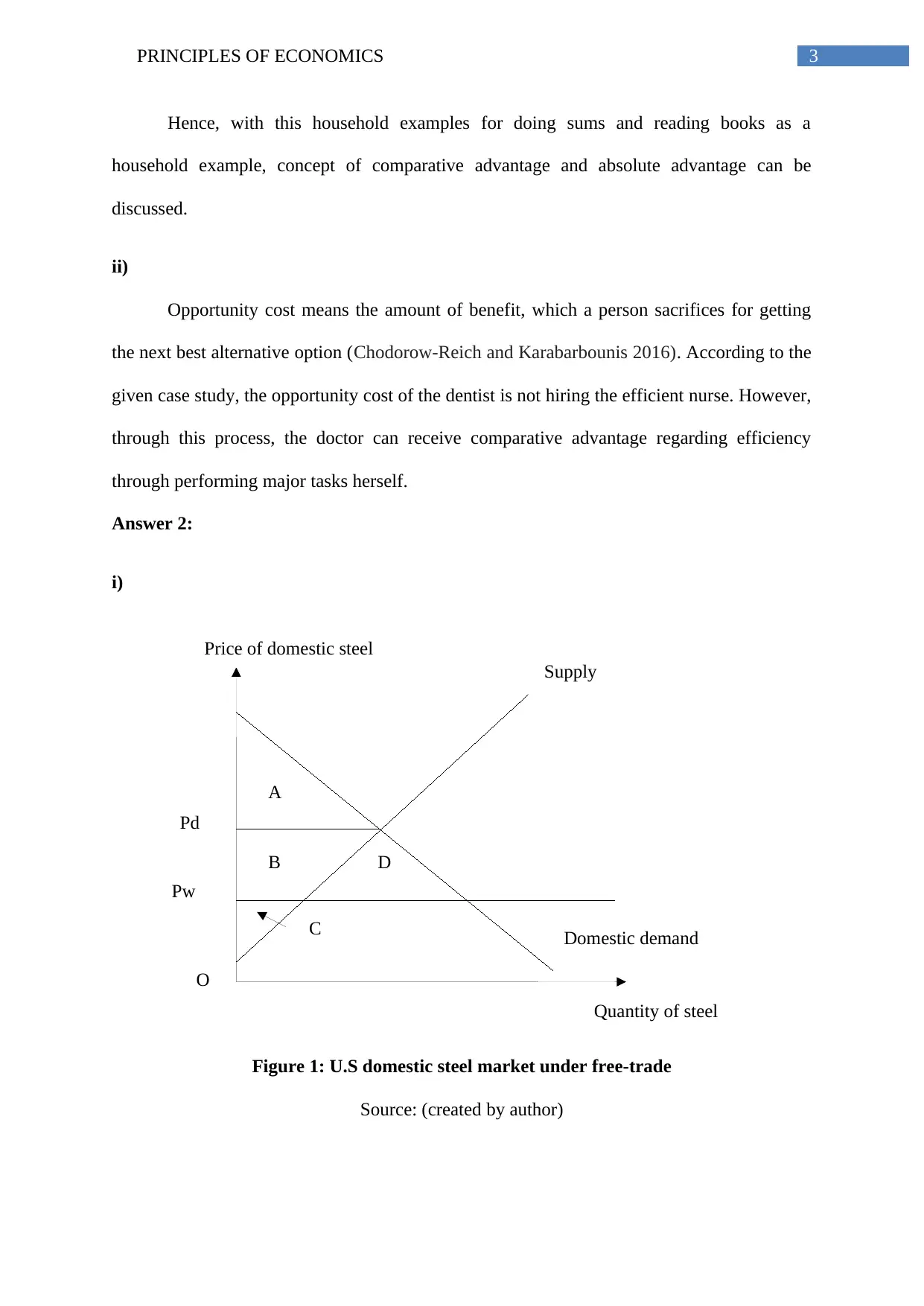
3PRINCIPLES OF ECONOMICS
Price of domestic steel
Supply
Domestic demand
Pd
Pw
A
B
C
Quantity of steel
O
D
Hence, with this household examples for doing sums and reading books as a
household example, concept of comparative advantage and absolute advantage can be
discussed.
ii)
Opportunity cost means the amount of benefit, which a person sacrifices for getting
the next best alternative option (Chodorow-Reich and Karabarbounis 2016). According to the
given case study, the opportunity cost of the dentist is not hiring the efficient nurse. However,
through this process, the doctor can receive comparative advantage regarding efficiency
through performing major tasks herself.
Answer 2:
i)
Figure 1: U.S domestic steel market under free-trade
Source: (created by author)
Price of domestic steel
Supply
Domestic demand
Pd
Pw
A
B
C
Quantity of steel
O
D
Hence, with this household examples for doing sums and reading books as a
household example, concept of comparative advantage and absolute advantage can be
discussed.
ii)
Opportunity cost means the amount of benefit, which a person sacrifices for getting
the next best alternative option (Chodorow-Reich and Karabarbounis 2016). According to the
given case study, the opportunity cost of the dentist is not hiring the efficient nurse. However,
through this process, the doctor can receive comparative advantage regarding efficiency
through performing major tasks herself.
Answer 2:
i)
Figure 1: U.S domestic steel market under free-trade
Source: (created by author)
Paraphrase This Document
Need a fresh take? Get an instant paraphrase of this document with our AI Paraphraser
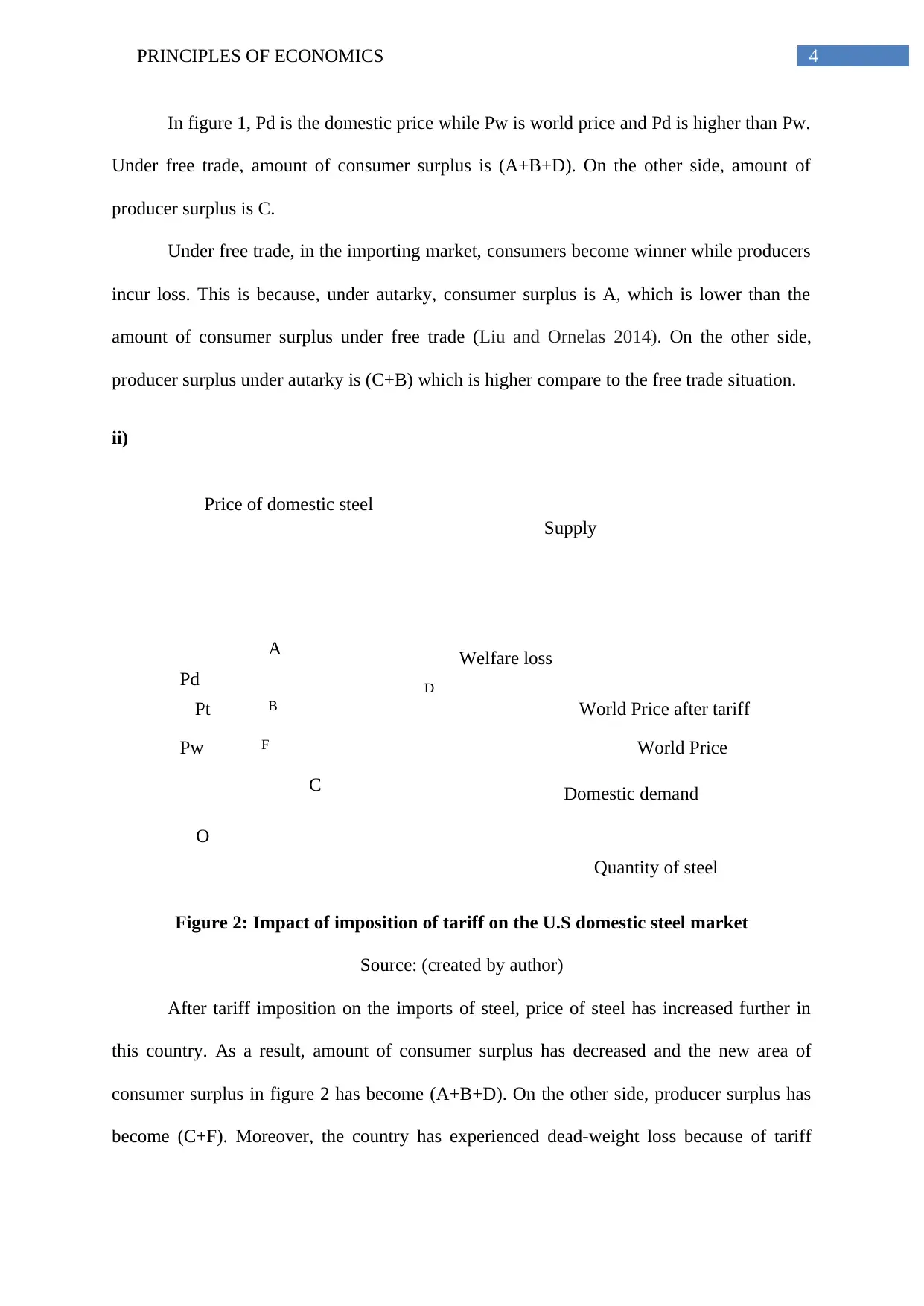
4PRINCIPLES OF ECONOMICS
Price of domestic steel
Supply
Domestic demand
World Price
Pd
Pw
A
B
C
Quantity of steel
O
D
World Price after tariffPt
F
Welfare loss
In figure 1, Pd is the domestic price while Pw is world price and Pd is higher than Pw.
Under free trade, amount of consumer surplus is (A+B+D). On the other side, amount of
producer surplus is C.
Under free trade, in the importing market, consumers become winner while producers
incur loss. This is because, under autarky, consumer surplus is A, which is lower than the
amount of consumer surplus under free trade (Liu and Ornelas 2014). On the other side,
producer surplus under autarky is (C+B) which is higher compare to the free trade situation.
ii)
Figure 2: Impact of imposition of tariff on the U.S domestic steel market
Source: (created by author)
After tariff imposition on the imports of steel, price of steel has increased further in
this country. As a result, amount of consumer surplus has decreased and the new area of
consumer surplus in figure 2 has become (A+B+D). On the other side, producer surplus has
become (C+F). Moreover, the country has experienced dead-weight loss because of tariff
Price of domestic steel
Supply
Domestic demand
World Price
Pd
Pw
A
B
C
Quantity of steel
O
D
World Price after tariffPt
F
Welfare loss
In figure 1, Pd is the domestic price while Pw is world price and Pd is higher than Pw.
Under free trade, amount of consumer surplus is (A+B+D). On the other side, amount of
producer surplus is C.
Under free trade, in the importing market, consumers become winner while producers
incur loss. This is because, under autarky, consumer surplus is A, which is lower than the
amount of consumer surplus under free trade (Liu and Ornelas 2014). On the other side,
producer surplus under autarky is (C+B) which is higher compare to the free trade situation.
ii)
Figure 2: Impact of imposition of tariff on the U.S domestic steel market
Source: (created by author)
After tariff imposition on the imports of steel, price of steel has increased further in
this country. As a result, amount of consumer surplus has decreased and the new area of
consumer surplus in figure 2 has become (A+B+D). On the other side, producer surplus has
become (C+F). Moreover, the country has experienced dead-weight loss because of tariff
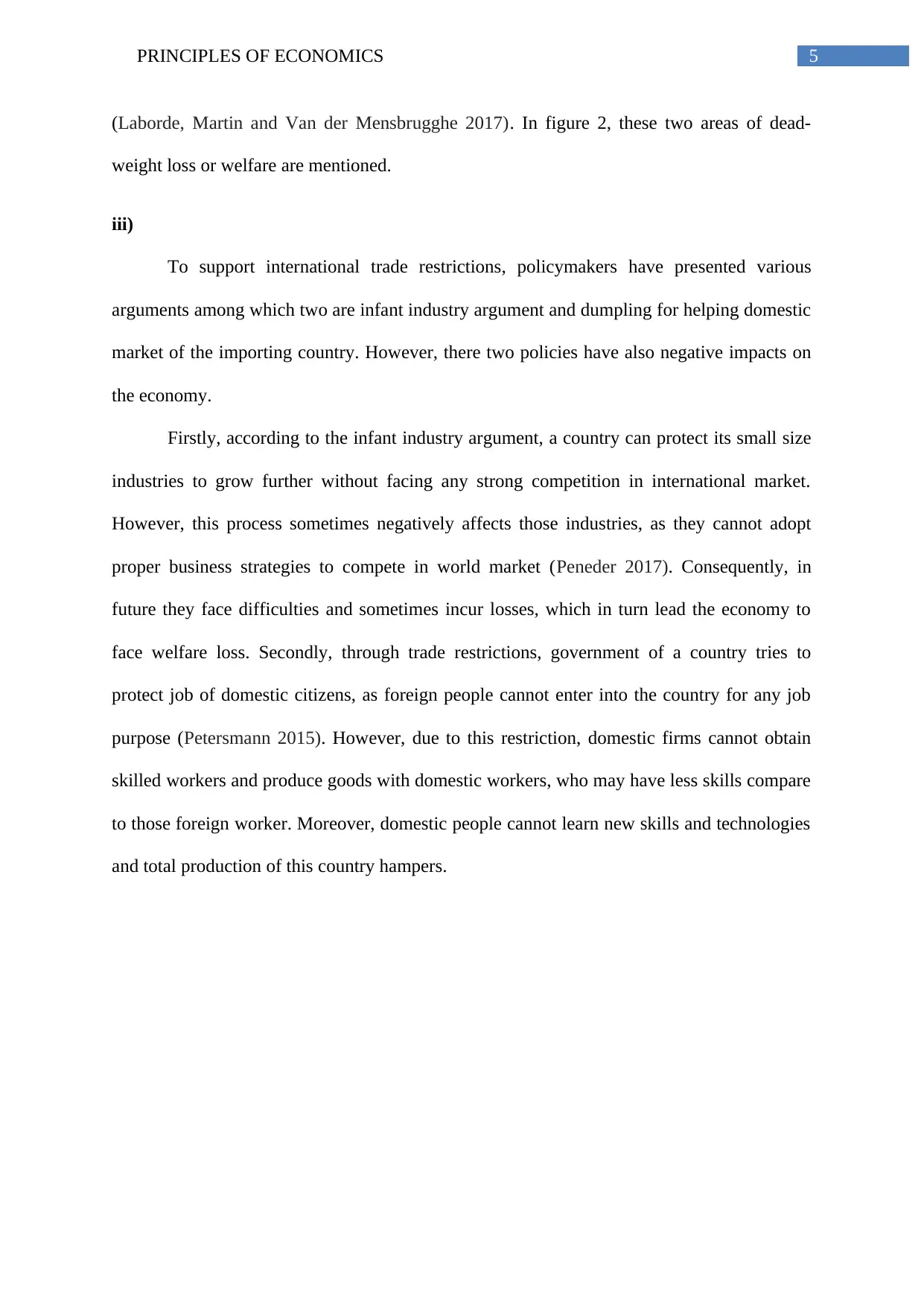
5PRINCIPLES OF ECONOMICS
(Laborde, Martin and Van der Mensbrugghe 2017). In figure 2, these two areas of dead-
weight loss or welfare are mentioned.
iii)
To support international trade restrictions, policymakers have presented various
arguments among which two are infant industry argument and dumpling for helping domestic
market of the importing country. However, there two policies have also negative impacts on
the economy.
Firstly, according to the infant industry argument, a country can protect its small size
industries to grow further without facing any strong competition in international market.
However, this process sometimes negatively affects those industries, as they cannot adopt
proper business strategies to compete in world market (Peneder 2017). Consequently, in
future they face difficulties and sometimes incur losses, which in turn lead the economy to
face welfare loss. Secondly, through trade restrictions, government of a country tries to
protect job of domestic citizens, as foreign people cannot enter into the country for any job
purpose (Petersmann 2015). However, due to this restriction, domestic firms cannot obtain
skilled workers and produce goods with domestic workers, who may have less skills compare
to those foreign worker. Moreover, domestic people cannot learn new skills and technologies
and total production of this country hampers.
(Laborde, Martin and Van der Mensbrugghe 2017). In figure 2, these two areas of dead-
weight loss or welfare are mentioned.
iii)
To support international trade restrictions, policymakers have presented various
arguments among which two are infant industry argument and dumpling for helping domestic
market of the importing country. However, there two policies have also negative impacts on
the economy.
Firstly, according to the infant industry argument, a country can protect its small size
industries to grow further without facing any strong competition in international market.
However, this process sometimes negatively affects those industries, as they cannot adopt
proper business strategies to compete in world market (Peneder 2017). Consequently, in
future they face difficulties and sometimes incur losses, which in turn lead the economy to
face welfare loss. Secondly, through trade restrictions, government of a country tries to
protect job of domestic citizens, as foreign people cannot enter into the country for any job
purpose (Petersmann 2015). However, due to this restriction, domestic firms cannot obtain
skilled workers and produce goods with domestic workers, who may have less skills compare
to those foreign worker. Moreover, domestic people cannot learn new skills and technologies
and total production of this country hampers.
⊘ This is a preview!⊘
Do you want full access?
Subscribe today to unlock all pages.

Trusted by 1+ million students worldwide
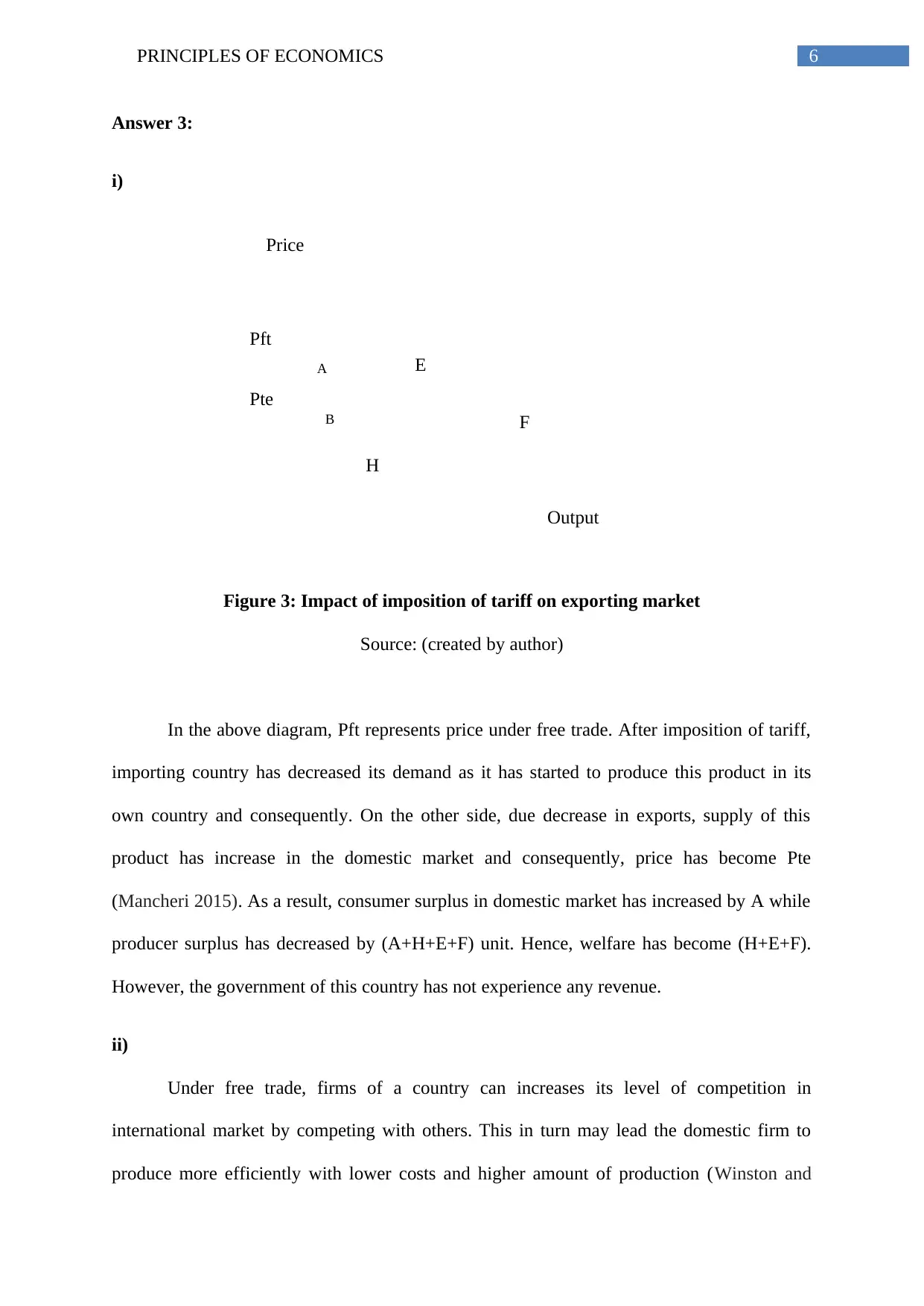
6PRINCIPLES OF ECONOMICS
Pft
A
B
E
F
Price
Output
H
Pte
Answer 3:
i)
Figure 3: Impact of imposition of tariff on exporting market
Source: (created by author)
In the above diagram, Pft represents price under free trade. After imposition of tariff,
importing country has decreased its demand as it has started to produce this product in its
own country and consequently. On the other side, due decrease in exports, supply of this
product has increase in the domestic market and consequently, price has become Pte
(Mancheri 2015). As a result, consumer surplus in domestic market has increased by A while
producer surplus has decreased by (A+H+E+F) unit. Hence, welfare has become (H+E+F).
However, the government of this country has not experience any revenue.
ii)
Under free trade, firms of a country can increases its level of competition in
international market by competing with others. This in turn may lead the domestic firm to
produce more efficiently with lower costs and higher amount of production (Winston and
Pft
A
B
E
F
Price
Output
H
Pte
Answer 3:
i)
Figure 3: Impact of imposition of tariff on exporting market
Source: (created by author)
In the above diagram, Pft represents price under free trade. After imposition of tariff,
importing country has decreased its demand as it has started to produce this product in its
own country and consequently. On the other side, due decrease in exports, supply of this
product has increase in the domestic market and consequently, price has become Pte
(Mancheri 2015). As a result, consumer surplus in domestic market has increased by A while
producer surplus has decreased by (A+H+E+F) unit. Hence, welfare has become (H+E+F).
However, the government of this country has not experience any revenue.
ii)
Under free trade, firms of a country can increases its level of competition in
international market by competing with others. This in turn may lead the domestic firm to
produce more efficiently with lower costs and higher amount of production (Winston and
Paraphrase This Document
Need a fresh take? Get an instant paraphrase of this document with our AI Paraphraser
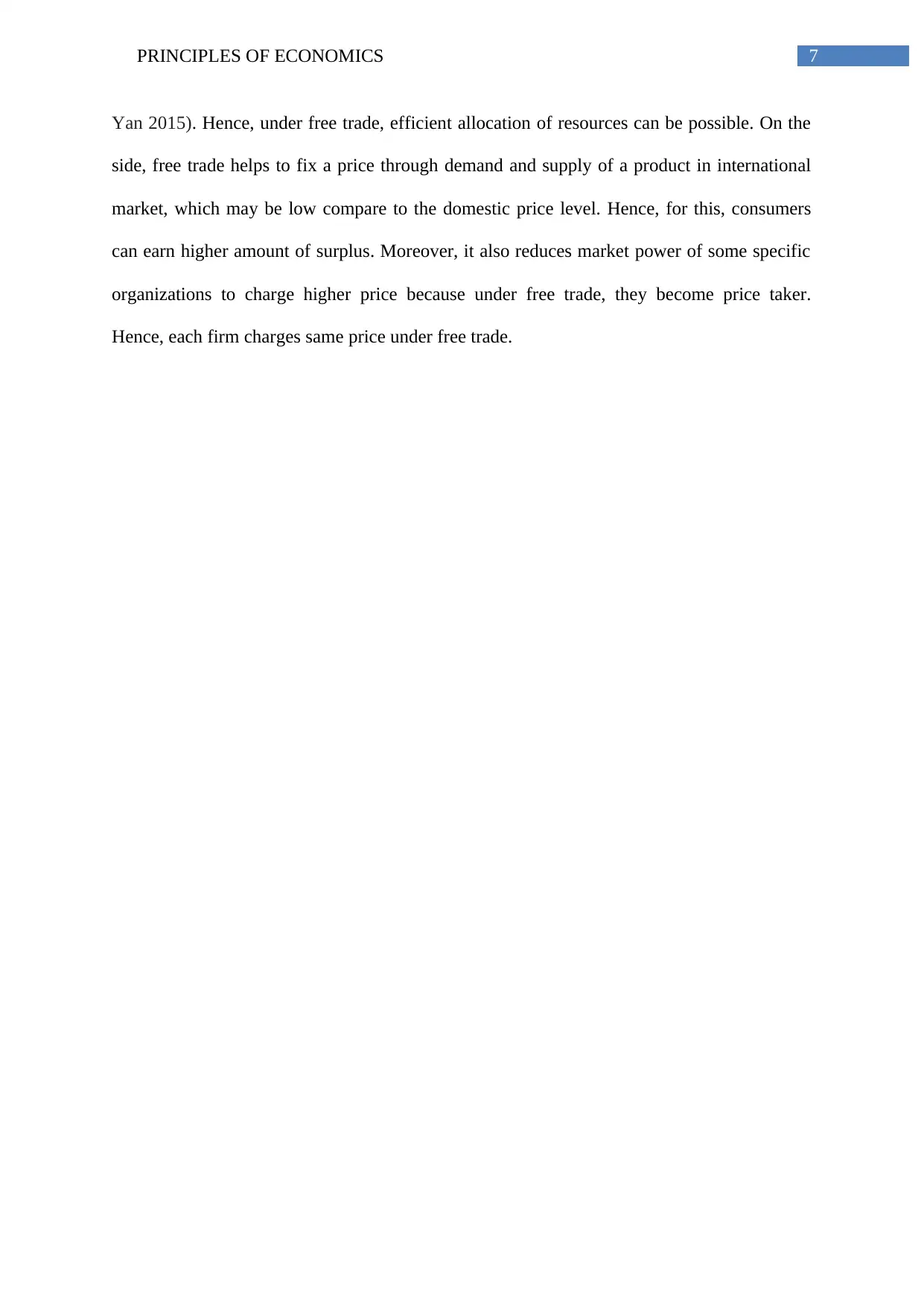
7PRINCIPLES OF ECONOMICS
Yan 2015). Hence, under free trade, efficient allocation of resources can be possible. On the
side, free trade helps to fix a price through demand and supply of a product in international
market, which may be low compare to the domestic price level. Hence, for this, consumers
can earn higher amount of surplus. Moreover, it also reduces market power of some specific
organizations to charge higher price because under free trade, they become price taker.
Hence, each firm charges same price under free trade.
Yan 2015). Hence, under free trade, efficient allocation of resources can be possible. On the
side, free trade helps to fix a price through demand and supply of a product in international
market, which may be low compare to the domestic price level. Hence, for this, consumers
can earn higher amount of surplus. Moreover, it also reduces market power of some specific
organizations to charge higher price because under free trade, they become price taker.
Hence, each firm charges same price under free trade.
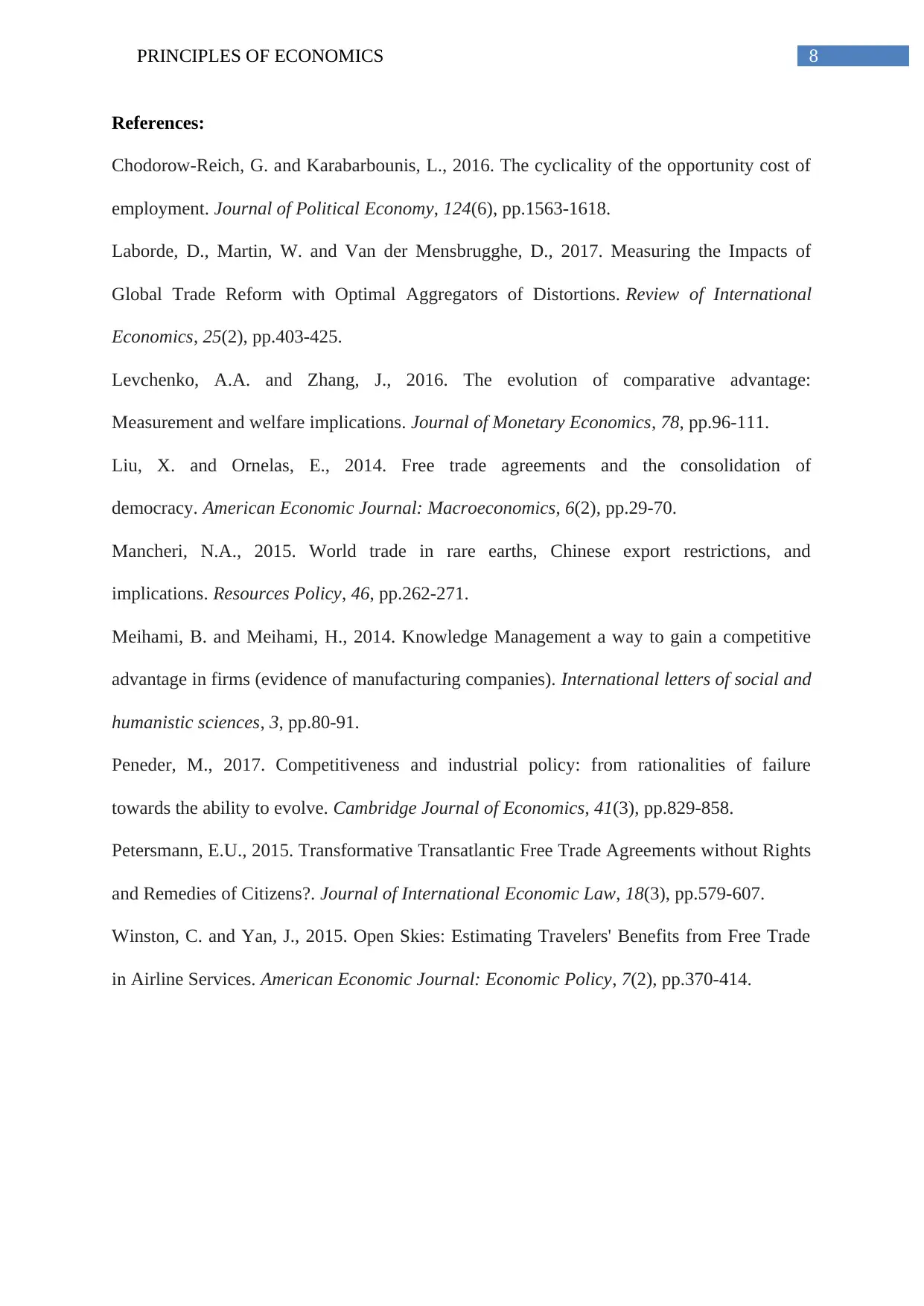
8PRINCIPLES OF ECONOMICS
References:
Chodorow-Reich, G. and Karabarbounis, L., 2016. The cyclicality of the opportunity cost of
employment. Journal of Political Economy, 124(6), pp.1563-1618.
Laborde, D., Martin, W. and Van der Mensbrugghe, D., 2017. Measuring the Impacts of
Global Trade Reform with Optimal Aggregators of Distortions. Review of International
Economics, 25(2), pp.403-425.
Levchenko, A.A. and Zhang, J., 2016. The evolution of comparative advantage:
Measurement and welfare implications. Journal of Monetary Economics, 78, pp.96-111.
Liu, X. and Ornelas, E., 2014. Free trade agreements and the consolidation of
democracy. American Economic Journal: Macroeconomics, 6(2), pp.29-70.
Mancheri, N.A., 2015. World trade in rare earths, Chinese export restrictions, and
implications. Resources Policy, 46, pp.262-271.
Meihami, B. and Meihami, H., 2014. Knowledge Management a way to gain a competitive
advantage in firms (evidence of manufacturing companies). International letters of social and
humanistic sciences, 3, pp.80-91.
Peneder, M., 2017. Competitiveness and industrial policy: from rationalities of failure
towards the ability to evolve. Cambridge Journal of Economics, 41(3), pp.829-858.
Petersmann, E.U., 2015. Transformative Transatlantic Free Trade Agreements without Rights
and Remedies of Citizens?. Journal of International Economic Law, 18(3), pp.579-607.
Winston, C. and Yan, J., 2015. Open Skies: Estimating Travelers' Benefits from Free Trade
in Airline Services. American Economic Journal: Economic Policy, 7(2), pp.370-414.
References:
Chodorow-Reich, G. and Karabarbounis, L., 2016. The cyclicality of the opportunity cost of
employment. Journal of Political Economy, 124(6), pp.1563-1618.
Laborde, D., Martin, W. and Van der Mensbrugghe, D., 2017. Measuring the Impacts of
Global Trade Reform with Optimal Aggregators of Distortions. Review of International
Economics, 25(2), pp.403-425.
Levchenko, A.A. and Zhang, J., 2016. The evolution of comparative advantage:
Measurement and welfare implications. Journal of Monetary Economics, 78, pp.96-111.
Liu, X. and Ornelas, E., 2014. Free trade agreements and the consolidation of
democracy. American Economic Journal: Macroeconomics, 6(2), pp.29-70.
Mancheri, N.A., 2015. World trade in rare earths, Chinese export restrictions, and
implications. Resources Policy, 46, pp.262-271.
Meihami, B. and Meihami, H., 2014. Knowledge Management a way to gain a competitive
advantage in firms (evidence of manufacturing companies). International letters of social and
humanistic sciences, 3, pp.80-91.
Peneder, M., 2017. Competitiveness and industrial policy: from rationalities of failure
towards the ability to evolve. Cambridge Journal of Economics, 41(3), pp.829-858.
Petersmann, E.U., 2015. Transformative Transatlantic Free Trade Agreements without Rights
and Remedies of Citizens?. Journal of International Economic Law, 18(3), pp.579-607.
Winston, C. and Yan, J., 2015. Open Skies: Estimating Travelers' Benefits from Free Trade
in Airline Services. American Economic Journal: Economic Policy, 7(2), pp.370-414.
⊘ This is a preview!⊘
Do you want full access?
Subscribe today to unlock all pages.

Trusted by 1+ million students worldwide
1 out of 9
Your All-in-One AI-Powered Toolkit for Academic Success.
+13062052269
info@desklib.com
Available 24*7 on WhatsApp / Email
![[object Object]](/_next/static/media/star-bottom.7253800d.svg)
Unlock your academic potential
Copyright © 2020–2025 A2Z Services. All Rights Reserved. Developed and managed by ZUCOL.


